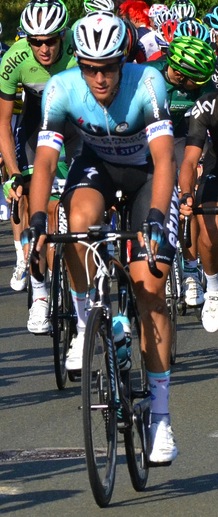
Valverde at Liège-Bastogne-Liège 2013 (from a photo by Flickr user flowizm used under a Creative Commons license)
Alejandro Valverde rode away decisively to win La Flèche Wallonne today, but since it was on the Mur de Huy, he did it very slowly (says the guy who would need mountain bike gearing to get up it at all). Bunch finishes in cycling usually mean a sprint to the line and La Flèche often has a bunch finish since it is shorter than the classics the week is bookended by. However, unlike the gallops finished off by Kittel, Greipel, and Cavendish, this one has different protagonists and happens at a more leisurely pace (leisurely might not be the right word, since the effort is not leisurely, just the pace of the result). The ramps topping out at 26% clearly make it a finish for the puncheurs, not the sprinters. Even if everyone makes to a kilometer to go together, they spread out quickly, as Valverde and his margin of victory showed.
Before the last trip of the day up the Mur, the break of the day included Preben Vav Hecke, who has now spent a lot of time on the front after riding in the break at Amstel as well (Gilbert might have lost his chance at a triple, but can Van Hecke get his own and make it into the break at Liège as well?), and Ramūnas Navardaukas, who was out taking the pressure off for Garmin and their reigning Liège-Bastogne-Liège champion Dan Martin. However, with all eyes on the Mur de Huy, the break was clearly doomed and they were reined in on the penultimate climb with around 15 k to go. After the demise of the break there were a couple short-lived attacks and a crash involving Damiano Cunego and Fränk Schleck, who can recuperate with his brother who went down at Amstel, on the run in to the Huy, but by the bottom of the climb everyone was together. After an attack by Romain Bardet of Ag2r kicked things off, the 5th place finisher at Amstel, Michal Kwiatkowski, went to the front. Dan Martin then showed that dropping out of Amstel was just for a little more rest for his sore knee and that he is on good form for his defense of Liège. Martin came around Kwiatkowski, but was quickly overcome by Valvarde, who powered around them both and had time to take his hands off the bars and celebrate before the finish.
The winner of the last two punchy races, Philippe Gilbert, will now not duplicate his annus mirabilis after being too far back at the base of the Mur de Huy. He may have been affected by the crash of Damiano Cunego and Fränk Schleck with a couple kilometers to go, but he was already a little to far back at that point, and it did not seem to be his day. He finished 10th, just behind last year’s winner Dani Moreno. Gilbert, Valverde and the rest are now looking ahead to La Doyenne on Sunday and are clearly the favorites, but Garmin has to be feeling pretty good about at least posting a good result for Martin’s defense. Not only did Martin finish second on the day, but, as mentioned, Navardaukas got into the break to take the pressure off them, and Tom Jelte Slagter was also right in the thick of things at the end, crossing the line in 5th. It should be some good racing on Sunday in Liège.





